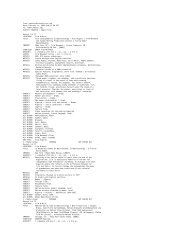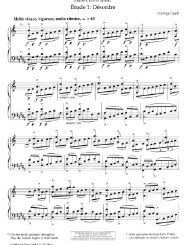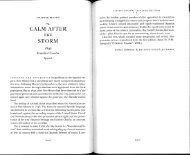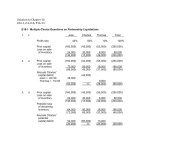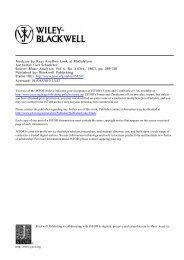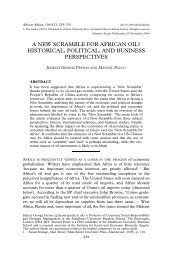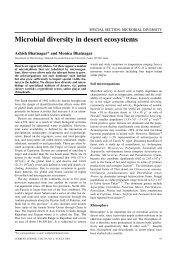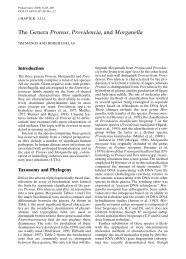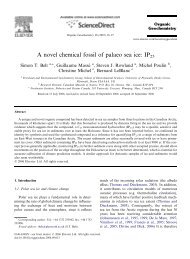The Genus Serratia
The Genus Serratia
The Genus Serratia
You also want an ePaper? Increase the reach of your titles
YUMPU automatically turns print PDFs into web optimized ePapers that Google loves.
242 F. Grimont and P.A.D. Grimont CHAPTER 3.3.11<br />
Matsumoto, K., Yamamoto, T., Kamata, R., Maeda, H. 1984.<br />
Pathogenesis of <strong>Serratia</strong>l infection: activation of the<br />
Hageman factor-prekallikein cascade by <strong>Serratia</strong>l protease.<br />
Journal of Biochemistry 96:739–749.<br />
Matsuyama, T., Murakami, T., Fujita, M., Fujita, S., Yano, I.<br />
1986. Extracellular vesicle formation and biosurfactant<br />
production by <strong>Serratia</strong> marcescens. Journal of General<br />
Microbiology 132:865–875.<br />
McCoy, R. H., Scidler, R. J. 1973. Potential pathogens in the<br />
environment: Isolation, enumeration, and identification<br />
of seven genera of intestinal bacteria associated with<br />
small green pet turtles. Applied Microbiology 25:534–<br />
538.<br />
McGeer, A., Low, D. E., Penner, J., Ng, J., Goldman, C.,<br />
Simor, A. E. 1990. Use of molecular typing to study the<br />
epidemiology of <strong>Serratia</strong> marcescens. Journal of Clinical<br />
Microbiology 28:55–58.<br />
Molla, A., Akaike, T., Maeda, H. 1989. Inactivation of various<br />
proteinase inhibitors and the complement system in<br />
human plasma by the 56-Kilodalton proteinase. Infection<br />
and Immunity 57:1868–1871.<br />
Molla, A., Matsumoto, K., Oyamada, I., Katsuki, T., Maeda,<br />
H. 1986. Degradation of protease inhibitors, immunoglobulins,<br />
and other serum proteins by <strong>Serratia</strong> protease<br />
and its toxicity to fibroblasts in culture. Infection and<br />
Immunity 53:522–529.<br />
Müller, H. E., Steigerwalt, A. G., Brenner, D. J. 1986. Isolation<br />
of <strong>Serratia</strong> fonticola from birds. Zbl. Bakt. Hyg. A<br />
261:212–218.<br />
Negut, M., Davis, B. R., Farmer III, J. J. 1975. Différenciation<br />
épidémiologique de <strong>Serratia</strong> marcescens: Comparaison<br />
entre lysotypie et sérotypie. Archives Roumaines de<br />
Pathologie Expérimentale et de Microbiologie 34:<br />
189.<br />
Ohshima, Y., Ohtomo, T., Yoshida, K. 1984. Encapsulation<br />
and mouse-virulence of <strong>Serratia</strong> marcescens strain SM-1<br />
and its variants in relation to colonial morphology. Acta<br />
Microbiologica Hungarica 31:55–60.<br />
Old, D. C., Adegbola, R., Scott, S. S. 1983. Multiple fimbrial<br />
haemagglutinins in <strong>Serratia</strong> species. Med. Microbiol.<br />
Immunol. 172:107–115.<br />
Olexy, V. M., Mucha, D. K., Bird, T. J., Grieble, H. G.,<br />
Farrand, S. K. 1982. An R plasmid of <strong>Serratia</strong> marcescens<br />
transferable to Pseudomonas aeruginosa. Chemotherapy<br />
28:6–17.<br />
O’Meara, R. A. Q. 1931. A simple, delicate and rapid method<br />
of detecting the formation of acetylmethylcarbinol by<br />
bacteria fermenting carbohydrate. Journal of Pathology<br />
and Bacteriology 34:401.<br />
Oxley, D., Wilkinson, S. G. 1988a. Studies of lipopolysaccharides<br />
from two strains (C.D.C. 3607–60 and IP 421) of<br />
<strong>Serratia</strong> marcescens O13: structure of the putative O13<br />
antigen. Carbohydrate Research 172:275–286.<br />
Oxley, D., Wilkinson, S. G. 1988b. Structural studies of glucorhamnans<br />
isolated from the lipopolysaccharides of<br />
reference strains for <strong>Serratia</strong> marcescens serogroups O4<br />
and O7, and of an O14 strain. Carbohydrate Research<br />
175:111–117.<br />
Paillot, A. 1916. Existence de plusieurs variétés et races de<br />
Coccobacilles dans les septicémies naturelles du Hanneton.<br />
Comptes Rendus Hebdomadaires des Séances de<br />
l’Académie des Sciences. 163:531–534.<br />
Paine, S. G., Berridge, E. M. 1921. Studies in bacteriosis. V.<br />
Further investigation of a suggested bacteriolytic action<br />
in Protea cynaroides affected with the leaf-spot disease.Annals<br />
of Applied Biology 8:20–26.<br />
Paine, S. G., Stansfield, H. 1919. Studies in bacteriosis.<br />
Annals of Applied Biology 6:27–39.<br />
Parès, Y. 1964. Action de <strong>Serratia</strong> marcescens dans le cycle<br />
biologique des métaux. Annales de l’Institut Pasteur.<br />
107:136–141.<br />
Perestelo, F., Falcon, M. A., De La Fuente, G. 1989. Production<br />
of vanillic acid from vanillin by resting cells of<br />
<strong>Serratia</strong> marcescens. Applied and Environmental Microbiology<br />
55:1660–1662.<br />
Pesson, P., Toumanoff, C., Haradas, C. 1955. Etude des<br />
épizooties bactériennes observées dans les élevages<br />
d’insectes xylophages (Rhyncolus porcatus Germain,<br />
Scolytus scolytus Fabricius, Scolytus (Scolytochelus) multistriatus<br />
Marsham). Annales des Epiphyties 6:315–328.<br />
Phaff, H. J., Miller, M. W. 1961. A specific microflora associated<br />
with the fig wasp, Blastophaga psenes Linnaeus.<br />
Journal of Insect Pathology 3:233–243.<br />
Podgwaite, J. D., Cosenza, B. J. 1976. A strain of <strong>Serratia</strong><br />
marcescens pathogenic for larvae of Lymantria dispar:<br />
Infectivity and mechanisms of pathogenicity. Journal of<br />
Invertebrate Pathology 27:199–208.<br />
Poole, K., Schiebel, E., Braun, V. 1988. Molecular characterization<br />
of the hemolysin determinant of <strong>Serratia</strong> marcescens.<br />
170:3177–3188.<br />
Quesenberry, K. E., Short, B. G. 1983. <strong>Serratia</strong> marcescens<br />
infection in a blue and gold macaw. Journal of the American<br />
Veterinary Medical Association. Chicago, 183:1302–<br />
1303.<br />
Reid, R. D. 1936. Studies on bacterial pigmentation. Journal<br />
of Bacteriology 31:205–210.<br />
Reid, J. D., Stoufer, S. D., Ogrydziak, D. M. 1982. Efficient<br />
transformation of <strong>Serratia</strong> marcescens with pBR322<br />
plasmid DNA. Gene 17:107–112.<br />
Reissbrodt, R., Rabsch, W. 1988. Further differentiation of<br />
Enterobacteriaceae by means of siderophore-pattern<br />
analysis. Zbl. Bakt. Hyg. A 268:306–317.<br />
Richard, C. 1972. Méthode rapide pour l’étude des réactions<br />
de rouge de méthyle et Voges-Proskauer. Annales de<br />
l’Institut Pasteur. 122:979–986.<br />
Roussel, A., Lucas, A., Bouley, G. 1969. <strong>Serratia</strong> marcescens<br />
(Bacillus prodigiosus), une bactérie de la pathologie<br />
comparée. Revue de Pathologie Comparée et de Médecine<br />
Expérimentale 6:27–29.<br />
Sakazaki, R. 1974. <strong>Genus</strong> IX. <strong>Serratia</strong> Bizio 1823, 288, 326.<br />
Buchanan, R. E., and Gibbons, N. E. (ed.) In: Bergey’s<br />
manual of determinative bacteriology, 8th ed. Baltimore,<br />
Williams & Wilkins.<br />
Salceda, S. R., Lapuz, J., Vizconde, R. 1973. <strong>Serratia</strong> marcescens<br />
endophthalmitis. Arch. Ophthalmol. 89:163.<br />
Schaberg, D. R., Alford, R. H., Anderson, R., Farmer III, J.<br />
J., Melly, M. A., Schaffner, W. 1976. An outbreak of<br />
nosocomial infection due to multiply resistant <strong>Serratia</strong><br />
marcescens: Evidence of interhospital spread. Journal of<br />
Infectious Diseases 134:181–188.<br />
Schiebel, E., Braun, V. 1989. Integration of the <strong>Serratia</strong><br />
marcescens haemolysin into human erythrocyte membranes.<br />
Molecular Microbiology 3:445–453.<br />
Sedlák, J., Dlabad, V., Motlikova, M. 1965. <strong>The</strong> taxonomy of<br />
the <strong>Serratia</strong> genus. Journal of Hygiene, Epidemiology,<br />
Microbiology, and Immunology 9:45–53.<br />
Shinde, P. A., Lukezic, F. L. 1974. Characterization and serological<br />
comparisons of bacteria of the genus Erwinia<br />
associated with discolored alfafa roots. Phytopathology<br />
64:871–876.<br />
Sifuentes-Osornio, J., Ruiz-Palacios, G. M., Gröschel, D. H.<br />
1986. Analysis of epidemiologic markers of nosocomial



